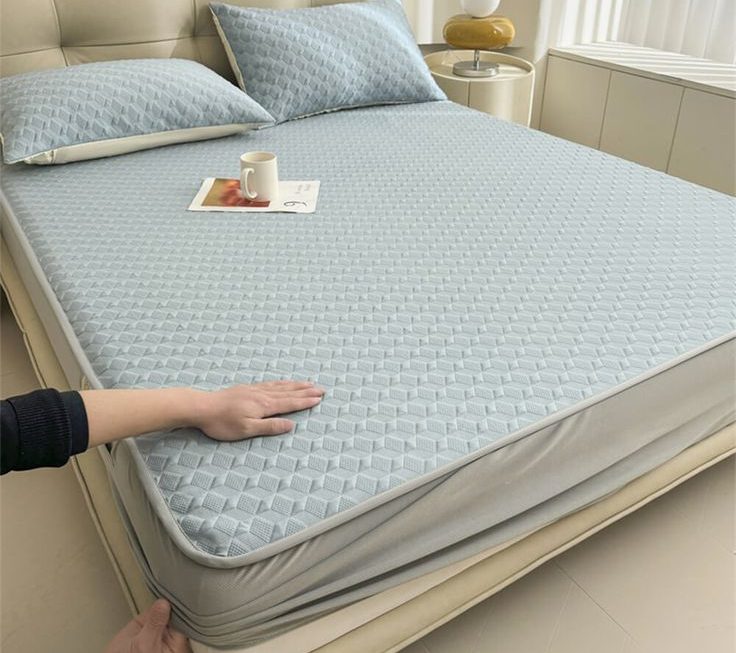Understanding the Flea Life Cycle in Carpets
Understanding fleas’ life cycles in carpets is key to controlling infestations. Carpets offer fleas a perfect place to grow through their various life stages. Let’s explore the life cycle stages.
Stage 1: Eggs
Fleas lay eggs on hosts, often pets. These eggs fall onto carpets. In carpets, they hatch within days.
Stage 2: Larvae
From eggs, larvae emerge. They feed on organic debris found in carpets, away from light.
Stage 3: Pupae
Larvae develop into pupae inside cocoons. These can be tough to remove and may stay in this stage for weeks or months, often in your carpet.
Stage 4: Adult Fleas
Pupae turn into adult fleas, which seek a blood meal. They need this to survive and reproduce. Adult fleas can live for months with the right conditions.
Recognizing each stage is crucial for targeting treatments effectively. Additionally, proper cleaning and preventive strategies can disrupt this cycle, reducing flea population.
Recognizing the Signs of a Carpet Flea Infestation
Identifying a flea infestation in your carpets is the first step to managing it. Here are indicators that fleas are living in your carpet:
Visual Detection of Fleas
Spotting fleas themselves, small brown insects that jump, is a clear sign. You might see them moving on the carpet or jumping to and from your pet.
Flea Droppings and Eggs
Known as ‘flea dirt’, these look like tiny black and white specks in your carpet. Flea eggs may appear as tiny white grains embedded in carpet fibers.
Unusual Pet Behavior
If pets frequently scratch or bite at their fur, this could signal fleas. They may be more restless than usual due to the irritation fleas cause.
Bites on Human Skin
Flea bites on humans typically involve small, red, itchy spots. These are often found around ankles and legs, showing fleas have moved beyond pets.
Presence of Larvae
You might notice flea larvae, which look like tiny, white worms. These can be more difficult to spot but will be in the same areas as eggs and adult fleas.
Spotting any of these signs means you should act quickly to address the infestation. Fleas can multiply rapidly, so early detection is crucial for effective control. Next, let’s discuss how fleas develop without a host and how you can combat them through regular cleaning methods.

Flea Development and Survival Without a Host
Exterminating fleas in carpets begins with understanding their development without a host. Flea larvae can feed on organic debris for several days to weeks, even without a blood meal. Yet, adult fleas generally need a host for survival.
Adult Fleas’ Dependence on a Host
Mature fleas, once pupae hatch, seek a host for the blood necessary for their life cycle. Without it, their ability to live and reproduce is compromised. Adult fleas can only survive a few days to a week without a host.
Fleas’ Ability to Hibernate
Fleas are resilient. They can lie dormant for months as pupae when a host is absent. In this state, they remain in carpets, waiting for conditions to change. It’s possible for homes, even those without pets, to experience sudden flea outbreaks when dormant eggs hatch.
Conditions for Flea Survival
Fleas can thrive in a range of conditions. Warm and humid environments allow them to live longer. However, cold and dry conditions reduce their lifespan, even when they have access to a host. Thus, temperature and humidity play a critical role in flea development.
Understanding these factors helps us determine how to manage flea populations. Regular cleaning and environmental control within homes are essential to make conditions unfavorable for fleas.

Regular Cleaning Methods to Combat Fleas in Carpets
To keep fleas at bay, frequent carpet cleaning is key. Employ these methods to reduce and eliminate flea populations from your carpets:
Daily Vacuuming
Vacuum daily to capture adult fleas, eggs, and larvae. Focus on areas where pets rest and fleas are most likely.
Washable Items
Launder pet bedding, blankets, and cushions often. Use hot water to kill fleas and their eggs.
Regular Dusting and Sweeping
Don’t overlook dusting and sweeping. These help remove fleas and debris they might feed on.
Targeted Areas
Pay extra attention to crevices and corners. Fleas and their eggs may hide in such spots.
Disposal of Vacuum Bags
Immediately dispose of vacuum bags or empties. This prevents fleas from escaping back to carpets.
Baking Soda
Sprinkle baking soda on carpets. It can dehydrate flea eggs and larvae, aiding in flea control.
Salt Treatment
Use finely ground salt on carpets. Let it sit overnight, then vacuum to kill flea stages.
Maintain these regular cleaning efforts consistently. This will disrupt the flea life cycle and help in controlling an infestation. Remember, persistence is key to keeping your living spaces flea-free.
Deep Cleaning Solutions: Steam Cleaning and Professional Services
Deep cleaning is vital for eradicating fleas deeply embedded in carpets. Consider the following options:
Steam Cleaning to Kill Fleas
Steam cleaning uses high temperatures to kill fleas, eggs, and larvae. This method penetrates carpet fibers, ensuring deep removal. Heat effectively exterminates all flea life stages, leaving your carpets clean.
Professional Carpet Cleaning Services
Professional cleaners have tools and expertise to combat fleas. They use specialized equipment and solutions that target flea infestations. After assessing your situation, they apply treatments that reach where vacuuming can’t. Their services help maintain a flea-free environment over time.
Benefits of Professional Flea Services
Experts offer thorough treatment, covering all infested areas. They ensure complete flea removal while keeping your home safe. The investment in professional help often saves time and ensures the job is done correctly. Experts can also advise on keeping fleas away in the future.
Opt for steam cleaning or professional services for effective flea control. These deep cleaning methods are more reliable than standard cleaning, especially for severe infestations. Pairing these services with regular maintenance prevents future outbreaks, protecting your home year-round.
Natural Remedies and Preventative Measures Against Fleas
When battling flea infestations, natural remedies can be effective. They offer safer alternatives for homes and pets. Here are methods to prevent and treat fleas naturally:
Use Essential Oils
Certain essential oils repel fleas. Examples include lavender, peppermint, and eucalyptus. Apply oils on pet collars or in areas where pets sleep. Remember, always dilute essential oils and consult a vet for pet safety.
DIY Flea Traps
Create flea traps using dish soap and water. Place bowls near flea hotspots overnight. Fleas get attracted, jump in, and can’t escape.
Regular Grooming
Groom pets often to check for fleas. Use a fine-toothed comb to remove any fleas or eggs.
Keep Your Yard Clean
Discourage wildlife, which can carry fleas, from your yard. Maintain trimmed lawns and remove debris.
Diatomaceous Earth
Apply food-grade diatomaceous earth to carpeted areas. This non-toxic powder dehydrates and kills fleas. Vacuum after a few days.
Frequent Laundering
Regularly wash pet bedding and any removable furniture covers. Hot water and high heat from a dryer will kill fleas and eggs.
Preventative measures help avoid infestations. These include
- keeping your home clean,
- using flea preventatives on pets, and
- treating infested areas promptly. By combining these natural methods with regular cleaning, reducing the chances of flea infestations significantly improves.

Employing Flea Treatments and Insecticides Safely
When dealing with a flea infestation, sometimes regular cleaning is not enough. Employing flea treatments or insecticides can be the next step. Yet, it is important to use these products safely to protect your household and pets. Here are some safety guidelines:
Choose Pet-Safe Products
Always select treatments that are safe for pets. Check labels and consult with a vet before using any product on or near pets.
Follow Instructions Carefully
Read and follow all directions on the product label. Misusing products can lead to ineffective treatment or harm to your home environment.
Ventilation is Key
When applying flea treatments, make sure the area is well-ventilated. Open windows and doors to allow fresh air to circulate. This reduces the risk of inhaling chemicals.
Wear Protective Gear
Protect yourself by wearing gloves and a mask when applying insecticides. This prevents skin contact and inhalation of chemicals.
Avoid Overuse
Resist the urge to overuse products. Applying too much can be dangerous and often does not increase effectiveness.
Keep Children and Pets Away
During application, keep children and pets out of the treated area until it is dry and safe. Follow the wait time specified on the product label.
Proper Storage
Store flea treatments and insecticides in secure places. Keep them out of reach of children and pets to prevent accidental ingestion.
Disposal of containers
Dispose of empty containers properly according to local regulations. Do not reuse them to prevent contamination.
By following these tips, you can safely incorporate flea treatments and insecticides into your flea control regimen. Remember, if you have concerns about using these products, consulting a professional pest control service is advisable.
Professional Pest Control: When to Seek Expert Intervention
Sometimes, despite our efforts, fleas persist. In such cases, professional pest control might be necessary. Here’s when to consider expert help:
Significant Flea Infestation
If you notice a severe flea presence that home remedies can’t manage, call experts. They can tackle large infestations safely and effectively.
Recurring Infestations
When fleas return after treatment, professionals can help. They identify and target the causes of reinfestation.
Safe Use of Chemicals
Professionals use chemicals safely. They prevent harm to pets and people in your home.
Comprehensive Treatment
Experts offer thorough treatment plans. They address all flea life stages, ensuring complete extermination.
Time and Cost Efficiency
Hiring a professional can save time and money. They deal with fleas quickly, preventing further damage or costs.
Expertise and Peace of Mind
A pest control professional has the training to handle infestations with expertise, giving you peace of mind knowing the issue is under control.
If fleas in your carpets are troubling you, don’t wait. Seek help from a pest control expert. They provide swift action and lasting solutions, allowing you to live comfortably and flea-free.



